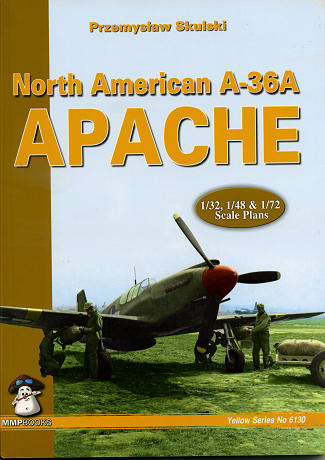Mushroom Model Publications' North American A-36
Apache
|
Author: |
Przemslaw Skulski |
|
Publisher |
Mushroom Models
Publications |
|
Price |
£15.99 MSRP |
|
Reviewer: |
Scott Van Aken
|
|
Notes: |
#6130, 128 pages, B5 format,
ISBN 978-83-61421-45-0 |
 The first of
the Mustangs to see US service was the A-36 dive bomber version. This aircraft
was built in rather small numbers and so was only operated by a few units. About
a year's worth of combat was enough to see their numbers dwindle to a level
where it was impossible to maintain extant airframes due to lack of spares, and
there just were not enough left around to take care of combat losses. So pretty
much mid-1943 to early/mid 1944 was it for the A-36's tenure. It was mostly used
in the Mediterranean theatre, though some, in concert with P-51As, were used
during the Burma campaign.
The first of
the Mustangs to see US service was the A-36 dive bomber version. This aircraft
was built in rather small numbers and so was only operated by a few units. About
a year's worth of combat was enough to see their numbers dwindle to a level
where it was impossible to maintain extant airframes due to lack of spares, and
there just were not enough left around to take care of combat losses. So pretty
much mid-1943 to early/mid 1944 was it for the A-36's tenure. It was mostly used
in the Mediterranean theatre, though some, in concert with P-51As, were used
during the Burma campaign.
Many readers undoubtedly call the A-36
the Mustang, but the author feels that it should be called the Apache and
provides his reasoning behind it. I am not sure what the crews called it, but it
may well have just been called A-36. The plane was an excellent dive bomber,
despite having difficulties with the dive brakes. These would sometimes not open
on one side, a problem when one is in a dive. Many attempts to fix it were made,
but there were still issues. Trust a Navy pilot to suggest that they just open
them prior to diving and if they did not work, do not use them. A DOH moment if
there ever was one.
The A-36 was powered by an Allison engine and
so was basically an aircraft that operated at low level. It was also used for
armed recce and a half dozen were used by the RAF's 1437 Flight with much
success. However, like USAAF units, the planes quickly succumbed to combat
losses and with no spares or replacements, their RAF life was short. However,
the aircraft was an excellent dog fighter at the low level and while not their
job, several shot down German planes with one pilot becoming an ace on the A-36.
This new book in MMP's Yellow series takes a look
at the design and development of the A-36 from the initial design through till
the last one rolled off the production lines. There were no variants aside from
a few recce installations. The
history section covers the use of the aircraft both by the US and the RAF.
At least three examples are extant with
one of the rebuilt back to flying status. This means that there are a goodly
number of color photos for the walk-around section of the book. This section not
only has great detail images, but is additionally enhanced by period photos and
sections from the maintenance manual. I should add that there are quite a few
period color images of these planes, something that is always nice to see. There are also a goodly
number of the color profiles we have all come to expect from MMP books. As an added bonus, there are scale plans included in 1/72, 1/48
and 1/32
scale, the latter two provided as huge foldouts that provided additional
detail drawings.
Overall, it is a most complete look at one of the
world's more interesting fighters. A book that continues the excellence of MMP products
and one that I can highly recommend to you.
April 2012
Review book courtesy of
Mushroom Models Publications
where you can order your copy. Australian readers can get theirs from
Platypus Publications, and US readers from Casemate Publishing.
If you would like your product reviewed fairly and quickly, please
contact
me or see other details in the
Note to
Contributors.
 The first of
the Mustangs to see US service was the A-36 dive bomber version. This aircraft
was built in rather small numbers and so was only operated by a few units. About
a year's worth of combat was enough to see their numbers dwindle to a level
where it was impossible to maintain extant airframes due to lack of spares, and
there just were not enough left around to take care of combat losses. So pretty
much mid-1943 to early/mid 1944 was it for the A-36's tenure. It was mostly used
in the Mediterranean theatre, though some, in concert with P-51As, were used
during the Burma campaign.
The first of
the Mustangs to see US service was the A-36 dive bomber version. This aircraft
was built in rather small numbers and so was only operated by a few units. About
a year's worth of combat was enough to see their numbers dwindle to a level
where it was impossible to maintain extant airframes due to lack of spares, and
there just were not enough left around to take care of combat losses. So pretty
much mid-1943 to early/mid 1944 was it for the A-36's tenure. It was mostly used
in the Mediterranean theatre, though some, in concert with P-51As, were used
during the Burma campaign.